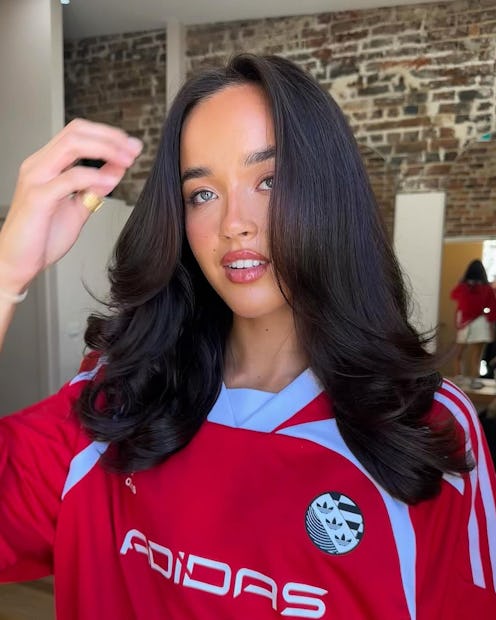(Hair)
A ‘Step Haircut’ Will Give You '90s Supermodel Hair Without Losing Length
It’s even low-maintenance.

The decision to hop on the latest “it” hairstyle isn’t always easy. Though getting a fresh chop may sound like a great idea, there are always some hangups, like the inevitable grow-out period which may or may not result in a few awkward months. Luckily, the step haircut trend is here to simplify things. Designed to simplify daily styling, it’s quickly becoming the industry’s best-kept secret for effortless hair. Unlike of-the-moment micro bobs and blunt shags, step-cutting uses graduated layers to create a lived-in look.
If you’re of a certain age, you may already be familiar with key elements of haircut as it stems from previously popular styles. According to Julien Farel, owner, and creative director at the Julien Farel Restore Salon and Spa in New York, the step cut first gained popularity in the ‘80s and remained in demand throughout the early ‘90s. So while today’s version isn’t a brand-new look, he tells TZR that it has a modern flair that makes it relevant. Layers will always be a quick and easy way to liven up your current style, but with this trend, you can have a one-of-a-kind look that’s tailored to your hair’s needs.
Below, TZR taps three of the industry’s top hairstylists to break down what makes step-cutting unique as well as how to customize the technique to your hair type and style.
What Is The Step Haircut?
Step-cutting is a technique that adds depth and dimension to the hair. In theory, the method can create a range of hairstyles, but the look is very distinct. “A step haircut is accomplished by cutting the hair at different lengths with a noticeable disconnection from one layer to the next,” says Farel. The sharp demarcation between the steps gives the effect of a staircase and shows a gradual distinction at each level.
According to Farel, the two-step style — featuring the shortest section above the shoulders and the next one just inches below — was popular during the ‘80s. However, today’s versions feature several steps and have a more modern feel. “A good example is Alicia Silverstone’s cut from the film Clueless,” says celebrity hair extensionist Priscilla Valles. She explains that the more steps incorporated into the style, the thinner the ends will be, giving the final look volume without bulk.
The Step Haircut Vs. Layers
There are a few trends that rely solely on layers for shape, like the beloved kitty and butterfly cuts. Farel tells TZR that, in some ways, step-cutting is similar. “This look also uses wide-spaced layers along the length of the hair, but the goal is different,” he says. The pro continues, noting that while traditional layers typically adhere to angular cutting techniques to achieve a more blended style, a step cut is supposed to be graduated to mimic ascending steps. With each new “layer” the sections of hair should be visible from the back. Valles adds that the difference between the two is even more apparent when curling, as the ends tend to create a noticeable flip.
What Hair Types Work Best With Step-Cutting?
While any hair type works with step cutting, the experts agree that those with medium to thick hair will best benefit from the technique. Valles notes by nature, the method creates movement. However, it’s also ideal for thinning out a longer style. “A step haircut works great on shorter lengths, but having that thickness is key to getting the most out of your cut,” she says. Jennifer Matos, a hairstylist at Rita Hazan Salon in NYC, adds that step-cutting will give your hair a more distinct appearance than standard layers. Even better? Farel highlights that both straight and curly textures can opt for a step cut as it will give off a totally different effect.
How To Style & Maintain A Step Haircut
Effortless styling is baked into this haircut trend thanks to the precisely cut sections. In that vein, Matos and Valles agree that a voluminous blowout is the best look to recreate at home. Blow dryers and round brushes do the job fine, but Valles notes that velcro rollers are just as effective. Maintaining your hairstyle sans tools relies on routine trims and trips to the salon. “Set a schedule with your stylist and opt for maintenance cuts every six to eight weeks,” says Matos. After all the work you put in, the last thing you want is to lose the style. “Controlling the re-growth helps preserve the shape and keeps the layers from becoming too long or unruly,” says Farel.
If you’re not quite ready to chop off significant length, this hair cutting technique makes for a great alternative.